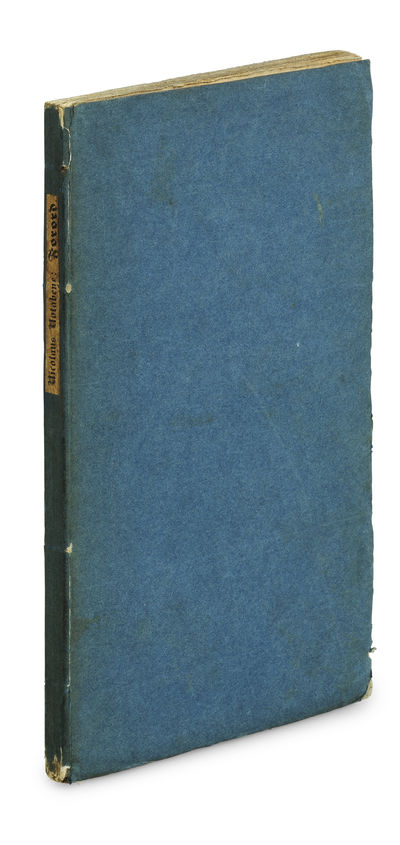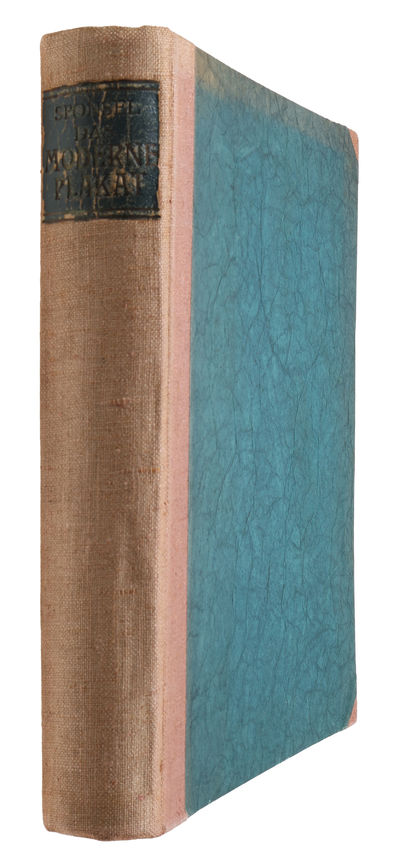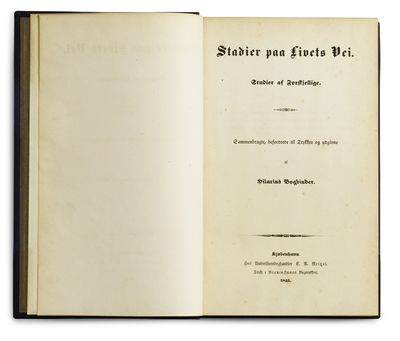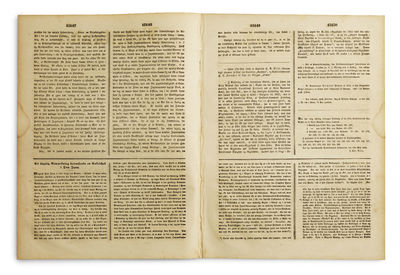ROIG, JAUME.
Libre de consells. - ["SCARCELY ANY SPANISH BOOK IS MORE RARE THAN THIS FIRST EDITION OF ROIG"]
Herman H. J. Lynge & Søn A/S
lyn62079
Valencia, Francisco Diaz Romano, 1531. 4to (205 x 145 mm). Exquisitely bound in a sumptuous richly blind-ornamented and gilt 20th century full calf binding. Five raised bands, gilt lettering, and smaller gilt decorations to richly blindstamped spine. Boards elaborately blindstamped with frames in different patterns and with smaller dispersed gilt ornamentations. Front board with a large centre-piece, also elaborately blindstamed and with gilt ornamentations, at the center of which the words “Libre de Consells de Jaume Roig” in gilt Gothic lettering. Back board with the same large centre-piece repeated, inside which a gilt centre-illustration (reminiscent of Bacchus) and the words “a bon seny no hi valengan” (Old Catalan for “common sense is not worth it”) in gilt lettering underneath. Binding signed Miquerlius to lower inside of front board. Single gilt line to edges of boards and broad inner gilt dentelles. All edges gilt. Leaf A4 with ink-annotations in contemporary hand. First leaves with marginal repairs and a closed wormtract, with loss of a few letters. Leaves L-O with closed wormtract in upper outer margin. Last leaves with marginal repairs and final leaf (woodcut illustration) with closed tear and a few wormholes, with minor loss of the illustration. With occasional brownspotting and a few leaves evenly browned. Washed. 139, (1) pp. (A-R8, S4)
The exceedingly rare first edition of Roig’s magnum opus, his seminal masterpiece of Catalan literature. This satirical work on women offering extensive advice on avoiding their alleged deceptive nature, the pitfalls of marriage, including all the misadventures Roig himself has suffered during four marriages is widely considered one of the most significant pieces of literature in Catalan. The first edition is of the utmost scarcity and hardly ever finds its way into the trade. Salva (author of “Catalogue of Spanish and Portuguese Books with occasional literary and bibliographical remarks”) only knew of two complete copies, and as early as 1735, the book was already so unprocurable that the editor of an attempted reprint had to omit some parts for lack of an early copy. Salva’s own copy is now housed in the British Library, who states: “Scarcely any Spanish book is more rare than this first edition of Roig, of which Carlos Ros, who edited the works of Roig in 1735, was unable to find any copy whatever. It was unknown to Nic. Antonio who quotes the second edition of 1532 as if it was the first”. It was written in 1459-60 and has only survived in one manuscript (MS. Vat. Lat. 4806). During the sixteenth century, however, several editions of Roig’s text were published, although with a modified title: Llibre de consells (Valencia, 1531 and 1532; Barcelona, 1561) and Llibre de les dones me´sverament dit de consells (Valencia, 1561); in recent years, it is often seen referred to as “The Espill” or "The Mirror". While the 15th century saw the emergence of other renowned literary works in Catalan, such as Tirant lo Blanc by Joanot Martorell and the anonymously written Curial e Güelfa, the present work distinguishes itself through its distinctive fusion of realism, social critique, sharp satire and, to some extent, medical knowledge. This combination makes it a remarkable portrayal of the evolving socioeconomic dynamics and cultural attitudes of Valencian society at the time: “(The present work) is mere fiction, but it is full of autobiographical elements and, despite the deformations imposed by the literary genre, it especially offers a very realistic picture of Valencian society in the 15th century and specifically of the city of Valencia. Roig describes very precise aspects of the trades and customs of the era and evokes real events which he knew about first-hand. He also furnishes priceless details on the knowledge and profession of medicine. In any event, as Antònia Carré accurately states, “the satirical deformations and comical inversions of Espill should be understood within the context of Galenic medicine.” (Ferrando, Catalan fiction in the 15th century, p. 37) ”The Espill (1460) (also called Libre de consells (Book of Advice) or Libre de les dones (Book of the Women) by its old publishers) seems to me to be one of the most singular works in 15th-century Valencian art as a consequence of the summa of a series of elements that its author, Jaume Roig (circa 1400-1478), mixes with unusual skill. Thus, its format (a narrative poem that consists of over sixteen thousand tetrasyllabic couplets), its subject matter (a misogynist satire with didactic and moralising contents), its external (a preface and four books divided into four sections) and internal (resort to fictitious autobiography in three of the four books) structures, the medieval traditions that channel the discourse (artes praedicandi, exempla, jokes...), the linguistic and rhetorical registers used (combining colloquial and vulgar language with learned terms), etc. However, Roig’s singularity must be understood equally in the literary context of 15th century Valencia, as interesting interrelations can be established between its creation and some of the most important works and authors of that time, ranging from Joanot Martorell to Joan Roís de Corella, passing through Isabel de Villena. On the other hand, it is also worth highlighting its wider context, for example in relation with its dialogue with the classical and biblical traditions or with the European (and Hispanic) “pro-” and “anti-feminist” debates of the 13th century, as Cantavella has analysed, within which it consolidates scientific and religious references, which are what are of most interest here” (Merida, Sodomy and the Sick Body of Women).In the 15th century, Catalan fiction flourished within the context of the Crown of Aragon's Mediterranean expansion marked by the rise of Valencia as its cultural center, a growing monetary economy, and increased interaction with other European regions, notably Italy, France and Burgundy. This rich environment produced several significant literary works including the present.“In the second half of the 15th century, writers from or imitating the bourgeoisie who liked to cultivate satirical and burlesque stories in verse, often in collaboration with one another, proliferated in Valencia. One of the most prominent was Jaume Roig... His Espill, is much more than a simple misogynistic satire: it is a true novel that quite skilfully describes the most grotesque aspects of the society of his day. (Ferrando, Catalan fiction on the 15th century, p. 37). Although bitter towards women in general, the work culminates in a glorification of the Virgin and finally in a beautiful full-page woodcut of the Virgin and Child with Saints Dorothy and Eulalie and two other saints - considered a masterpiece of the late Spanish Gothic style. Jaume Roig (circa 1400 – 1478) was a Valencian doctor and medical advisor to Dona Maria, wife of Alfonso V. “He studied Medicine and Arts and soon became a prominent doctor in the city, where he combined his medical practice with reading and writing. In 1443 he married Isabel Pellisser with whom he had six children. Jaume Roig's Espill was one of the most important works of the fifteenth century. His writing was in the romantic tradition of narrative in verse, not to mention the misogynist didactic tradition with comic and instructive elements. Espill consists of 16,359 couplets by means of which the narrator addresses his nephew, warning him about the ill-treatment he has received from women and therefore advising him to keep away from the female sex. Divided into an introductory poem, a Preface and four "books", Espill had a great impact in its day, so much so that four editions were published in the sixteenth century.” (Associació d'Escriptors en Llengua Catalana). Palau 275503: "rarissima" Lyell, p. 118: "very rare" Brunet IV, 1356: "fort rare"
The exceedingly rare first edition of Roig’s magnum opus, his seminal masterpiece of Catalan literature. This satirical work on women offering extensive advice on avoiding their alleged deceptive nature, the pitfalls of marriage, including all the misadventures Roig himself has suffered during four marriages is widely considered one of the most significant pieces of literature in Catalan. The first edition is of the utmost scarcity and hardly ever finds its way into the trade. Salva (author of “Catalogue of Spanish and Portuguese Books with occasional literary and bibliographical remarks”) only knew of two complete copies, and as early as 1735, the book was already so unprocurable that the editor of an attempted reprint had to omit some parts for lack of an early copy. Salva’s own copy is now housed in the British Library, who states: “Scarcely any Spanish book is more rare than this first edition of Roig, of which Carlos Ros, who edited the works of Roig in 1735, was unable to find any copy whatever. It was unknown to Nic. Antonio who quotes the second edition of 1532 as if it was the first”. It was written in 1459-60 and has only survived in one manuscript (MS. Vat. Lat. 4806). During the sixteenth century, however, several editions of Roig’s text were published, although with a modified title: Llibre de consells (Valencia, 1531 and 1532; Barcelona, 1561) and Llibre de les dones me´sverament dit de consells (Valencia, 1561); in recent years, it is often seen referred to as “The Espill” or "The Mirror". While the 15th century saw the emergence of other renowned literary works in Catalan, such as Tirant lo Blanc by Joanot Martorell and the anonymously written Curial e Güelfa, the present work distinguishes itself through its distinctive fusion of realism, social critique, sharp satire and, to some extent, medical knowledge. This combination makes it a remarkable portrayal of the evolving socioeconomic dynamics and cultural attitudes of Valencian society at the time: “(The present work) is mere fiction, but it is full of autobiographical elements and, despite the deformations imposed by the literary genre, it especially offers a very realistic picture of Valencian society in the 15th century and specifically of the city of Valencia. Roig describes very precise aspects of the trades and customs of the era and evokes real events which he knew about first-hand. He also furnishes priceless details on the knowledge and profession of medicine. In any event, as Antònia Carré accurately states, “the satirical deformations and comical inversions of Espill should be understood within the context of Galenic medicine.” (Ferrando, Catalan fiction in the 15th century, p. 37) ”The Espill (1460) (also called Libre de consells (Book of Advice) or Libre de les dones (Book of the Women) by its old publishers) seems to me to be one of the most singular works in 15th-century Valencian art as a consequence of the summa of a series of elements that its author, Jaume Roig (circa 1400-1478), mixes with unusual skill. Thus, its format (a narrative poem that consists of over sixteen thousand tetrasyllabic couplets), its subject matter (a misogynist satire with didactic and moralising contents), its external (a preface and four books divided into four sections) and internal (resort to fictitious autobiography in three of the four books) structures, the medieval traditions that channel the discourse (artes praedicandi, exempla, jokes...), the linguistic and rhetorical registers used (combining colloquial and vulgar language with learned terms), etc. However, Roig’s singularity must be understood equally in the literary context of 15th century Valencia, as interesting interrelations can be established between its creation and some of the most important works and authors of that time, ranging from Joanot Martorell to Joan Roís de Corella, passing through Isabel de Villena. On the other hand, it is also worth highlighting its wider context, for example in relation with its dialogue with the classical and biblical traditions or with the European (and Hispanic) “pro-” and “anti-feminist” debates of the 13th century, as Cantavella has analysed, within which it consolidates scientific and religious references, which are what are of most interest here” (Merida, Sodomy and the Sick Body of Women).In the 15th century, Catalan fiction flourished within the context of the Crown of Aragon's Mediterranean expansion marked by the rise of Valencia as its cultural center, a growing monetary economy, and increased interaction with other European regions, notably Italy, France and Burgundy. This rich environment produced several significant literary works including the present.“In the second half of the 15th century, writers from or imitating the bourgeoisie who liked to cultivate satirical and burlesque stories in verse, often in collaboration with one another, proliferated in Valencia. One of the most prominent was Jaume Roig... His Espill, is much more than a simple misogynistic satire: it is a true novel that quite skilfully describes the most grotesque aspects of the society of his day. (Ferrando, Catalan fiction on the 15th century, p. 37). Although bitter towards women in general, the work culminates in a glorification of the Virgin and finally in a beautiful full-page woodcut of the Virgin and Child with Saints Dorothy and Eulalie and two other saints - considered a masterpiece of the late Spanish Gothic style. Jaume Roig (circa 1400 – 1478) was a Valencian doctor and medical advisor to Dona Maria, wife of Alfonso V. “He studied Medicine and Arts and soon became a prominent doctor in the city, where he combined his medical practice with reading and writing. In 1443 he married Isabel Pellisser with whom he had six children. Jaume Roig's Espill was one of the most important works of the fifteenth century. His writing was in the romantic tradition of narrative in verse, not to mention the misogynist didactic tradition with comic and instructive elements. Espill consists of 16,359 couplets by means of which the narrator addresses his nephew, warning him about the ill-treatment he has received from women and therefore advising him to keep away from the female sex. Divided into an introductory poem, a Preface and four "books", Espill had a great impact in its day, so much so that four editions were published in the sixteenth century.” (Associació d'Escriptors en Llengua Catalana). Palau 275503: "rarissima" Lyell, p. 118: "very rare" Brunet IV, 1356: "fort rare"
Adress:
Silkegade 11
DK-1113 Copenhagen Denmark
Telefon:
CVR/VAT:
DK 16 89 50 16
E-post:
Webb:
![Libre de consells. - ["SCARCELY ANY SPANISH BOOK IS MORE RARE THAN THIS FIRST EDITION OF ROIG"] (photo 1)](https://d3525k1ryd2155.cloudfront.net/h/839/156/1685156839.0.l.0.jpg)
![Libre de consells. - ["SCARCELY ANY SPANISH BOOK IS MORE RARE THAN THIS FIRST EDITION OF ROIG"] (photo 2)](https://d3525k1ryd2155.cloudfront.net/h/839/156/1685156839.1.l.0.jpg)
![Libre de consells. - ["SCARCELY ANY SPANISH BOOK IS MORE RARE THAN THIS FIRST EDITION OF ROIG"] (photo 3)](https://d3525k1ryd2155.cloudfront.net/h/839/156/1685156839.2.l.0.jpg)
![Libre de consells. - ["SCARCELY ANY SPANISH BOOK IS MORE RARE THAN THIS FIRST EDITION OF ROIG"] (photo 4)](https://d3525k1ryd2155.cloudfront.net/h/839/156/1685156839.3.l.0.jpg)
![Libre de consells. - ["SCARCELY ANY SPANISH BOOK IS MORE RARE THAN THIS FIRST EDITION OF ROIG"] (photo 5)](https://d3525k1ryd2155.cloudfront.net/h/839/156/1685156839.4.l.0.jpg)
![Libre de consells. - ["SCARCELY ANY SPANISH BOOK IS MORE RARE THAN THIS FIRST EDITION OF ROIG"] (photo 6)](https://d3525k1ryd2155.cloudfront.net/h/839/156/1685156839.5.l.0.jpg)
![Libre de consells. - ["SCARCELY ANY SPANISH BOOK IS MORE RARE THAN THIS FIRST EDITION OF ROIG"] (photo 7)](https://d3525k1ryd2155.cloudfront.net/h/839/156/1685156839.6.l.0.jpg)
![Libre de consells. - ["SCARCELY ANY SPANISH BOOK IS MORE RARE THAN THIS FIRST EDITION OF ROIG"] (photo 8)](https://d3525k1ryd2155.cloudfront.net/h/839/156/1685156839.7.l.0.jpg)
![Libre de consells. - ["SCARCELY ANY SPANISH BOOK IS MORE RARE THAN THIS FIRST EDITION OF ROIG"] (photo 9)](https://d3525k1ryd2155.cloudfront.net/h/839/156/1685156839.8.l.0.jpg)
![Libre de consells. - ["SCARCELY ANY SPANISH BOOK IS MORE RARE THAN THIS FIRST EDITION OF ROIG"] (photo 10)](https://d3525k1ryd2155.cloudfront.net/h/839/156/1685156839.16.l.jpg)
![Libre de consells. - ["SCARCELY ANY SPANISH BOOK IS MORE RARE THAN THIS FIRST EDITION OF ROIG"] (photo 11)](https://d3525k1ryd2155.cloudfront.net/h/839/156/1685156839.17.l.jpg)
![Libre de consells. - ["SCARCELY ANY SPANISH BOOK IS MORE RARE THAN THIS FIRST EDITION OF ROIG"] (photo 12)](https://d3525k1ryd2155.cloudfront.net/h/839/156/1685156839.18.l.jpg)





